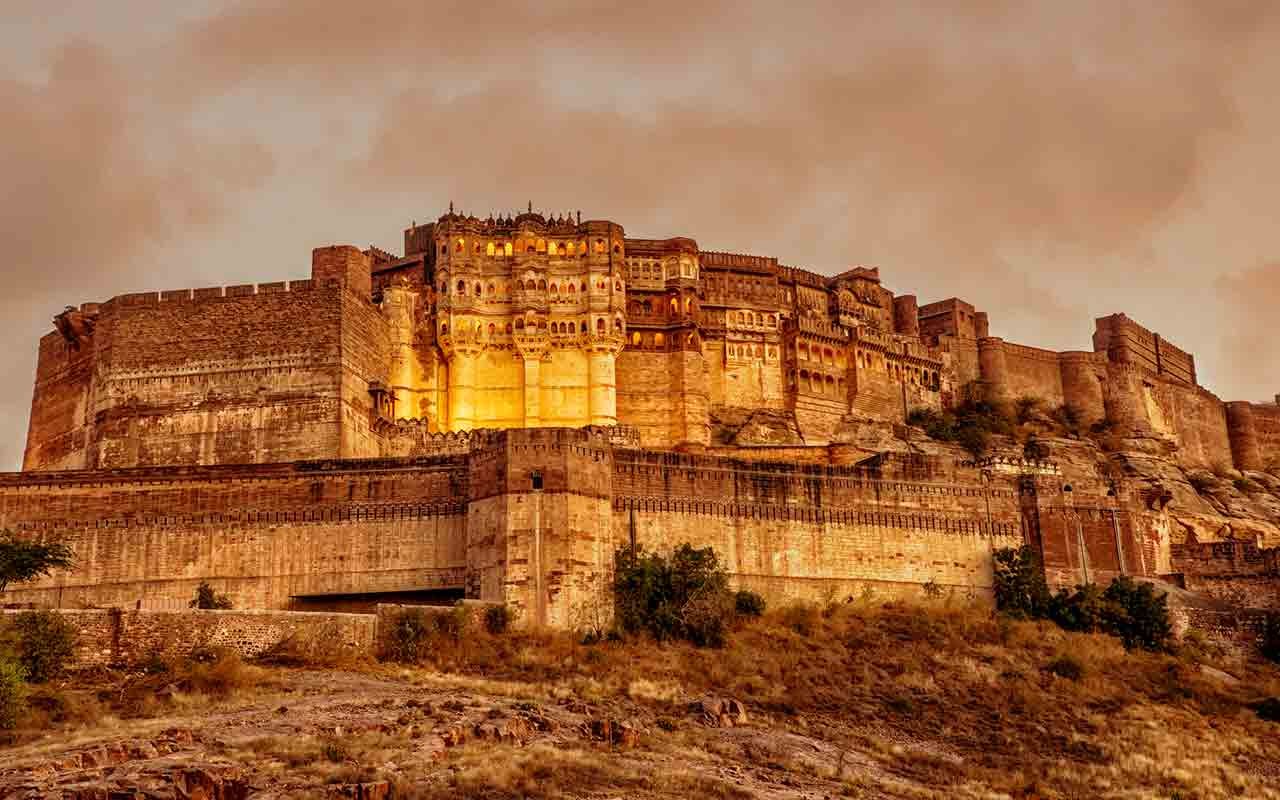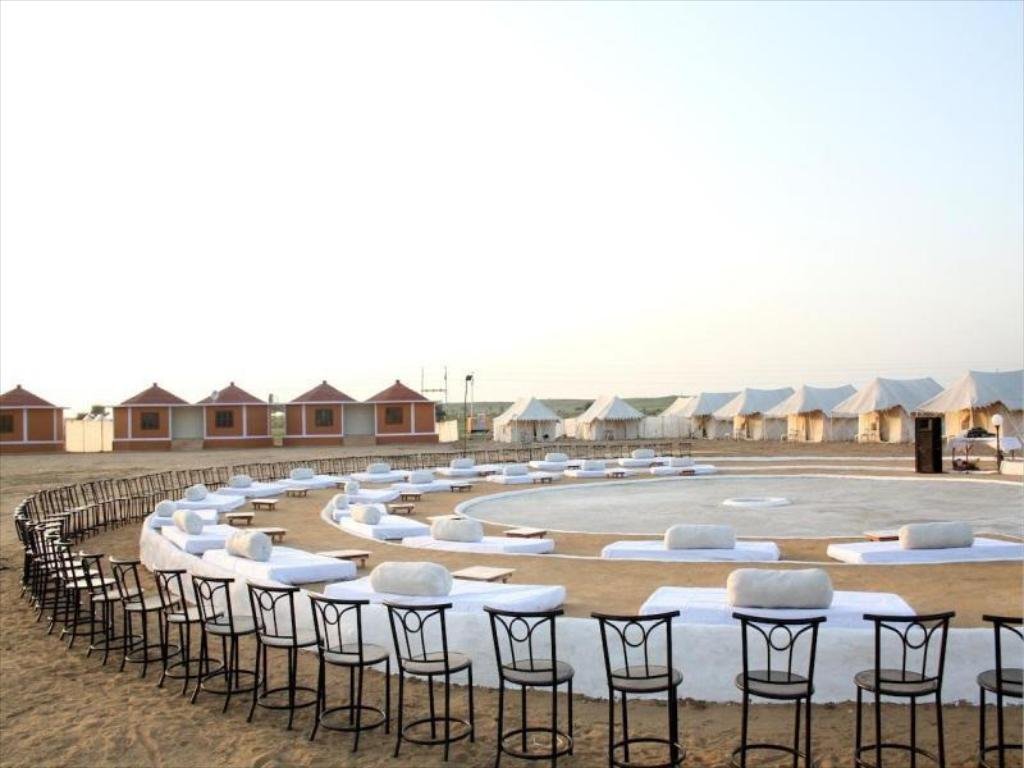Colors of Rajasthan
Duration: 07 Days - 06 Nights
Highlights:Jaipur | Jodhpur | Jaisalmer | Chokhi Dhani | Tent Stay | Camel Ride | Forts | Folk Dance | Sand Dunes
Jaipur Arrival & Sightseeing
Arrive at Jaipur Airport / Railway Station and proceed to hotel and check in. After some rest visit Birla Temple and Nahargarh Fort (Sunset view over city). Evening visit Chokhi Dhani for Rajasthani traditional dinner with dance and music. Overnight stay at hotel.
Jaipur Sightseeing
Post breakfast proceed for full day city tour as below.
Amber Fort - This magnificent fort comprises an extensive palace complex, built from pale yellow and pink sandstone, and white marble, and is divided into four main sections, each with its own courtyard. Enjoy an Elephant ride to ascend to the Fort.
City Palace - The palace was built between 1729 and 1732 AD by Sawai Jai Singh II. He ruled in Amer and planned and built the outer walls of the palace and later rulers added to the architecture of this palace. Jantar Mantar - A collection of nineteen architectural astronomical instruments, built by the Rajput king Sawai Jai Singh II, and completed in 1734 century. It features the world's largest stone sundial, and is a UNESCO World Heritage site.
Jaipur Jodhpur via Ajmer & Pushkar (Approx 350 Kms / 07 Hrs - 08 Hrs Drive)
Post breakfast checkout and proceed to Jodhpur. En-route stop at Ajmer & Pushkar. Visit Ajmer Sharif Dargah, the domed shrine of the Muslim Sufi saint Garib Nawaz. Later visit Pushkar, best known for its Brahma Temple built in the 14th century standing on a high platform near Pushkar Lake. This is the only temple in the world where Lord Brahma - Creator of the Universe, is worshipped. While Pushkar is a city of pilgrimage with over 500 temples and ghats, it is also famous for its annual Camel Fair. By night arrive at Jodhpur and check in hotel. Overnight stay at hotel.
Jodhpur Sightseeing
Post breakfast proceed for full day sightseeing as below.
Mehrangarh Fort - Built by Rao Jodha in 1459 in Jodhpur, is one of the largest forts in the country. It is situated at the top of a 410 feet elevated hill and guarded by massive walls. The intricate carvings on the walls of the fort, the sprawling courtyards, its impressive history, striking palaces, museums and galleries allure tourists from all over the world. The fort also has one of the well-stocked museums of Rajasthan. There are six different galleries in the Mehrangarh Museum: Elephant's howdahs, Palanquins, Daulat Khana, Armoury, Paintings and the Turban Gallery. National Geological Monument, Nagnecha Mataji Temple, Chamunda Temple and Rao Jodha Desert Rock Park are the tourist attractions in Mehrangarh Fort. Flying - Fox activity is also conducted around the Fort.
Jaswant Thada - A splendid marble cenotaph monument that is also a mausoleum for the kings of Marwar. The memorial was built in the honor and memory of Maharaja Jaswant Singh II by his son Maharaja Sardar Singh in 1899 and is still used by the Marwar Royal Family as cremation grounds. On the steps leading up to the monument, one can see local musicians and folk dancers entertain the visitors. Umaid Bhawan Palace - A wonderful amalgamation of a fascinating past and a luxurious present. It is, at the same time - a heritage hotel, a museum and the residence of the Royal Family of the present owner, Raja Gaj Singh. In addition to being of a historical landmark, the palace was commissioned in 1929, was built in order to provide employment to the drought and grief-stricken farmers of the area and thus took longer to complete. One part is the residence of the royal family, where the tourists are not allowed to enter. The second houses a museum which displays a rich collection of photographs, arms, clocks, stuffed animals and many other possessions of the royal family. The third part of the palace has been converted into a five-star hotel and offers the most exquisite services to its clientele. It is one of the most popular hotels in Jodhpur.
Mandore Garden - Famous for its wide green expanses, exquisite architecture and royal cenotaphs, Mandore Garden of Jodhpur is indeed a sight to behold. he garden is a part of the more massive Mehrangarh Fort, and also houses the famous Hall of Heroes and the temple of Three Hundred Million Gods. The garden also has a Government Museum, which is full of artefacts and old relics. Ghanta Ghar - The Ghanta Ghar in Jodhpur is a magnificent clock tower in the centre of the city, built by Maharaja Sardar Singh about 200 years ago. Known as the clock tower of Rajasthan, it is a popular landmark that signifies the start of Old Jodhpur. The tower offers a brilliant panoramic view of the city from the top
Jodhpur Jaisalmer & Sightseeing (Approx 285 Kms / 05 Hrs Drive)
Post breakfast checkout and proceed to Jaisalmer; "The Golden City". Arrive at Jaisalmer and check in hotel. After some rest proceed for sightseeing as below.
Jaisalmer Fort - Located on the southern edge of the city and is popularly known as 'Sonar Qila' or 'Golden Fort'. A UNESCO World Heritage Site, it falls under the category of 'Hill Forts of India'. The fort stands at an impressive height of 250 ft. and is surrounded by a 30 ft. tall walls. Owing to its altitude, it offers a stunning and panoramic view of Jaisalmer city draped in golden yellow! Gadisar Lake - This reservoir was built by Raja Rawal Jaisal keeping in mind the need of his people. Located close to the fort of Jaisalmer, the lake is an easy respite from the hot and dry desert climate. Gadisar Lake offers scenic and picturesque views of the lake and the adjacent fort, especially when the eastern sky is blood red and the sun rises, striking its rays on the top floors of Jaisalmer Fort. Overnight stay at hotel.
Jaisalmer Sightseeing - Sam Sand Dunes (Approx 40 Kms One-way / 01 Hr Drive)
Post breakfast checkout and visit
Nathmalji Ki Haveli - This Haveli is famous for its architecture that reflects the fusion of both Rajput and Islamic styles. The facade of this haveli includes birds, elephants, flowers, bicycle, steam engine and soldiers. The entrance of the haveli is guarded by two huge elephants carved from yellow stone. The intricately carved jharokha windows and balconies are examples of the illustrious craftsmanship of Muslim silavats who created poetry in stone at the wondrous Nathmalji ki Haveli. In fact the stone-carved screen windows at the Nathmalji ki Haveli are famous for resembling magnified pieces of intricately carved jewelry. In addition to this, there are many pictures engraved on the walls including that of cattle, horses and flowers.
Patwon Ki Haveli - Renowned for its ornate wall paintings, intricate yellow sandstone-carved jharokas or balconies, gateways and doorways. The haveli is built using yellow sandstone and the main gateway is brown in colour. The haveli is five stories high divided into six apartments. The walls also feature beautiful mirror work and several paintings. There is a stunning apartment which is flawlessly painted with beautiful murals. There are about 60 balconies in the haveli.
Salim Singh Ki Haveli - The architecture of this haveli is unique as compared to the other havelis. This mansion was not created with the help of cements and mortar- the stones are connected with strong iron rods. The architecture of this mansion is inspired by dancing peacock. The mansion has five storeys and every structure is carefully built and carved.
Later proceed to Sam Sand Dunes ; a truly magnificent stretch of sweeping dunes, with sparse or no vegetation. The 3 km long, and 1 km wide sand dunes reflect the true image of Rajasthan. Undeniably one of the most picturesque spots in the desert, the Sam Sand Dunes have gained tremendous tourist reputation over the time. The unrelieved ocean of sand constantly changes its appearance at every gentle gush of wind. The whirling air currents of this area match with those of the sandstorms in the Sahara. On arrival check in at Desert Camp. In evening take Camel Ride enjoying the magic of dunes followed by Cultural Performance by Local Artists at Campsite. Overnight stay in Swiss Tents.
Jaislamer Departure
Post breakfast checkout and take drop at Jaisalmer Airport / Railway Station for your return journey.



